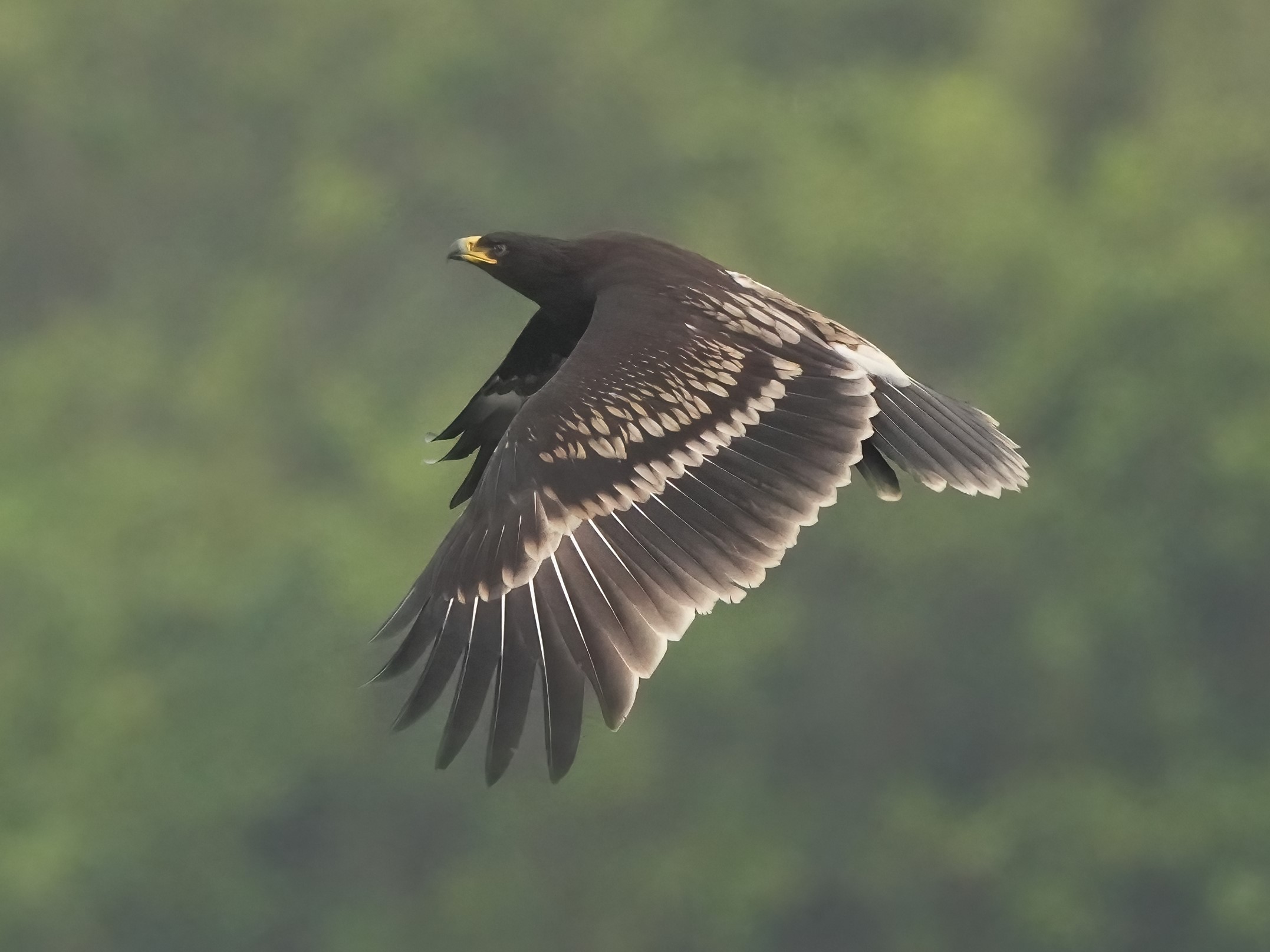Greater Spotted Eagle Clanga clanga 烏鵰
Category I. Scarce winter visitor to northern New Territories, mainly Deep Bay area, and rare passage migrant.
IDENTIFICATION

Nov. 2019, Michelle and Peter Wong.
59-71 cm. More compact than Imperial Eagle with a slightly shorter more round-cornered tail, relatively broader wings, slightly bulging secondaries, round nostrils and more distinct yellow gape and cere. Soars on nearly flat wings, glides with wings tipped slightly downwards. Plumage all dark in adult with small white flash at base of outer primaries on underwing and evenly worn flight feathers.

Dec. 2012, Martin Hale.
Older non-adults have a few indistinct spots and flight feathers that are of different ages and are thus variably worn and untidy.
The rare fulvescens morph in adult plumage has body and lesser and median coverts pale bright buff, darker around eyes, on breast and leading edge to wing. In juvenile plumage wings and tail are typical.

Dec. 2016, Kinni Ho. Juvenile.
Juvenile has broad buff tips to wing coverts and scapulars (somewhat variable in extent), evenly worn flight feathers with diffuse pale tips to secondaries and inner primaries, white band across uppertail coverts and paler underside to primaries. The distinct yellow gape and cere is visible here.

Oct. 2023, Paul Leader. Juvenile.
This darker juvenile has less extensive buff on the forewings. Second-winter birds have fewer and smaller pale tips to wing coverts and unevenly worn flight feathers.
VOCALISATIONS
Not known to vocalise in HK.
DISTRIBUTION & HABITAT PREFERENCE
Most records occur in the northwest New Territories as far inland as Kam Tin, but mainly in the Deep Bay area and particularly at Mai Po. Away from there, there have been records at Ap Lei Chau, Lai Chi Chong, Sai Kung Town, Ng Tung Chai, Tai Po Kau and Mui Wo (the only record on Lantau). Single migrants have been recorded from Po Toi on three occasions: one that arrived from the northeast on 16 January 2007, one flying northeast on 17 March 2009 and one on 26 October 2014. At Long Valley it has been recorded on less than ten occasions.
Both Greater Spotted and Imperial Eagles appear to roost in forest areas of Tai Lam Chung, and birds have been recorded in flight to and from there in the evening and early morning.
OCCURRENCE
Greater Spotted Eagle is a winter visitor to the northwest New Territories mainly recorded from the last week of October to mid-March. Figure 1 illustrates the pattern of records at Mai Po NR, where observer effort has been relatively consistent during the period. The peak from the last week of October to the third week of November may reflect greater visibility of newly-arrived birds, though it is perhaps more likely to include passage migrants. Migrants are also occasionally noted in late March and the first half of April. Extreme dates are 9 October 2008 and 13 April 2003.
Figure 2 illustrates the peak count per winter period at Mai Po NR from 1984/85 to 2019/20. It appears that against a background of increased observer activity, there has been no increase in numbers recorded since the 1990s, which may indicate a decrease in numbers has occurred. The highest single-site counts occurred in the 1990s: six at Mai Po on 14 November 1990 and during coordinated Deep Bay area waterbird counts on 16 January 1994 and 11 January 1997. Most reports are of one or two birds.
There are six records of the ‘fulvescens’ morph, all singles at Mai Po: 15 January to 11 February 1985, 14 November 1992 to 2 March 1993 and 16 October 1993 to 19 February 1994 (possibly same individual of the previous winter), 8 November 2007, 22 October 2008 and 13-15 November 2013.
Owing to uncertainties over the identification of eagles Aquila that were not resolved until the 1980s, there are relatively few early records, with two at Ping Shan on 11 October 1959 the first. It may, however, have been scarce before then since La Touche (1892, 1931-34) reported it collected just once on the coast of eastern Guangdong and only occasionally found it in Fujian.
BEHAVIOUR, FORAGING & DIET
Dead birds are the only food items reported, those identified being Grey Heron (Tipper 1992), a Little Egret thought to have died a few days previously and a Black-headed Gull stolen from a Black Kite. Tipper (1992) described interactions at a heron carcass between this species and Eastern Marsh Harrier.
Generally solitary. Birds can be seen roosting on trees in the southern part of Mai Po NR, especially in the afternoon before flying to night roost in Tai Lam Country Park.
RANGE & SYSTEMATICS
Monotypic. Breeds from eastern Europe east through Russia, northern Kazakhstan, northern Mongolia and northeast China to southern Ussuriland; winters in scattered areas of southern Europe, northeast Africa, the Middle East, northern Indian subcontinent, Indochina and south China (Meyburg et al. 2020). In China summer visitor to northern Xinjiang and west Heilongjiang, and winter visitor south of the Chang Jiang (Yangtze River) (Liu and Chen 2020).
CONSERVATION STATUS
IUCN: VULNERABLE. Population size 3,900 to 10,000 and suspected of decreasing by 30% in three generations due to habitat loss and persecution.
Figure 1.

Figure 2.

La Touche, J. D. D. (1892). On Birds collected or observed in the Vicinity of Foochow and Swatow in South-eastern China. Ibis 1892 400-430, 477-503.
La Touche, J. D. D. (1931-34). Handbook of the birds of Eastern China Vol. 2. Taylor and Francis, London.
Liu, Y. and Y. H. Chen (eds) (2020). The CNG Field Guide to the Birds of China (in Chinese). Hunan Science and Technology Publication House, Changsha.
Tipper, R. P. (1992). Spotted Eagle scavenging on prey of Imperial Eagle. Hong Kong Bird Report 1991: 195-196.
Meyburg, B.-U., G. M. Kirwan, and E. F. J. Garcia (2020). Greater Spotted Eagle (Clanga clanga), version 1.0. In Birds of the World (J. del Hoyo, A. Elliott, J. Sargatal, D. A. Christie, and E. de Juana, Editors). Cornell Lab of Ornithology, Ithaca, NY, USA. https://doi.org/10.2173/bow.grseag1.01

